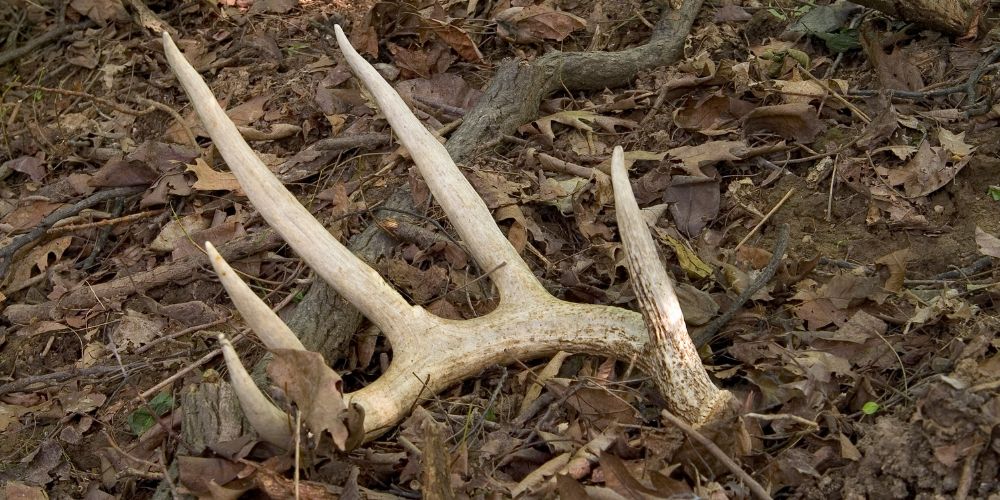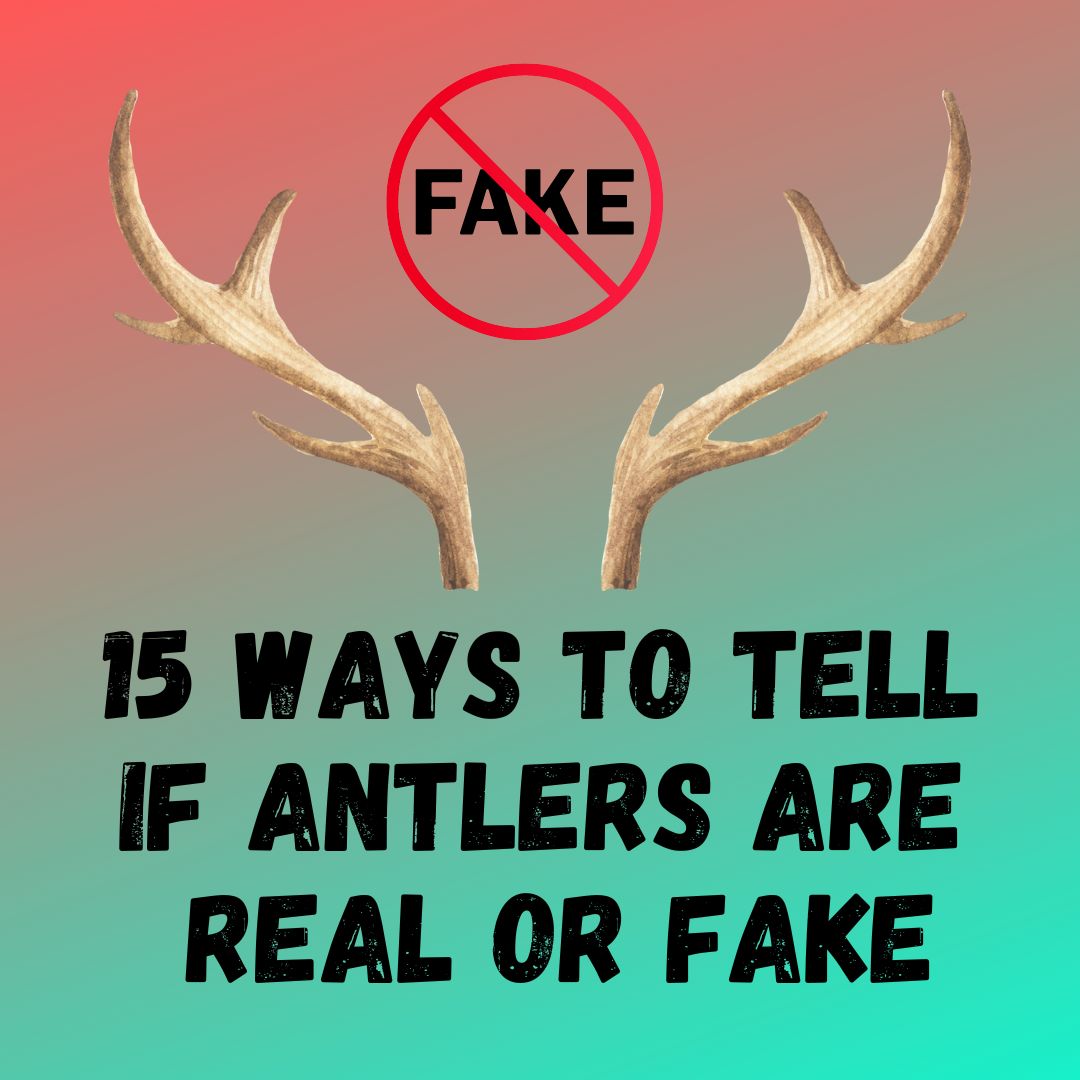If you’re trying to determine if antlers are real or fake, here are some tips to help you:
- Look for signs of attachment: Real antlers are attached to the skull of the animal, while fake antlers are often attached to a headband or other accessory. Look closely at the base of the antlers to see if there are any signs of attachment to a skull, such as a bony plate or skull cap.
- Check for seams: If the antlers appear to be made of multiple pieces, it may be a sign that they are fake. Real antlers are usually made of one solid piece of bone, while fake antlers may be made of plastic or other materials that have been molded together.
- Examine the texture: Real antlers have a rough, porous texture, while fake antlers may have a smoother, more uniform texture. If the antlers feel too smooth or have an unnatural shine to them, they may be fake.
- Look for natural imperfections: Real antlers often have natural imperfections, such as nicks, scratches, and variations in color. If the antlers appear too perfect or uniform in color and shape, they may be fake. Real antlers will have natural imperfections, such as bumps, ridges, and cracks, that are not present on fake antlers.
- Consider the weight: Real antlers are heavy and dense, while fake antlers are often much lighter. If the antlers feel too lightweight or hollow, they may be fake.
- Joints: Real antlers will have visible joints where they attach to the skull, while fake antlers may not. Look closely at the base of the antlers to see if there are any signs of a joint or if the antlers appear to be glued onto a base.
- Check for Odor or Scent: Real antlers may have a faint scent of bone or animal musk, while fake antlers will not.
- Look for Visible Pores: Real antlers will have visible pores on the surface, while fake antlers will be smooth and uniform. Real antlers will have a distinct, earthy smell, while fake antlers will not have any odor.
- Look for a Core: Real antlers will have a core running through the center, while fake antlers will not.
- Check for Hollow Parts: Real antlers will have some hollow parts, especially near the tips, while fake antlers will be solid throughout.
- Check for Color Variation: Real antlers will have natural variations in color, while fake antlers will be a uniform color.
- Look for Signs of Damage: Real antlers may have signs of wear and tear, such as scratches, dents, or missing tines, while fake antlers will not.
- Check the Base: Real antlers will have a bumpy, uneven base where they attach to the skull, while fake antlers will have a smooth base.
- Check for Symmetry: Real antlers will have some natural asymmetry, while fake antlers will be perfectly symmetrical.
- Look for Growth Rings: Real antlers will have visible growth rings, similar to those found in trees, while fake antlers will not.
- Check the Price: Real antlers are typically more expensive than fake antlers, as they are more rare and difficult to obtain.
- Check the Source: Real antlers are typically obtained from hunting or from naturally shed antlers, while fake antlers are manufactured in a factory.
- Consult an Expert: If you are unsure whether antlers are real or fake, it may be helpful to consult an expert, such as a taxidermist or a wildlife biologist, who can examine the antlers and provide a professional opinion.
In summary, to determine if antlers are real or fake, look for signs of attachment, check for seams, examine the texture, look for natural imperfections, and consider the weight of the antlers.

What is inside a deer antler?
Inside a deer antler, there is a network of living tissues and blood vessels that supply the antler with nutrients and oxygen. The core of the antler is made up of spongy bone tissue that is surrounded by a layer of harder, denser bone.
During the growing season, the antler is covered in a soft, velvety skin that contains blood vessels and nerves. This skin helps to nourish the antler and promote its growth. Once the antler has fully grown, the velvet dries up and falls off, leaving behind a hard, bony structure.
At this point, the living tissues inside the antler begin to die off, leaving a hollow core. The antler is still attached to the deer’s skull at the base, where it is anchored by a bony plate. Overall, the inside of a deer antler is a complex and fascinating structure that reflects the deer’s unique biology and natural history.
What does a deer antler feel like?
A deer antler feels hard and dense, with a rough, porous texture. The texture of the antler can vary depending on the age and health of the deer, as well as the time of year. During the growing season, the antlers are covered in a soft, velvety coating that helps to nourish and protect them as they develop.
Once the antlers have fully grown and the velvet has shed, the antlers become hard and dense. When you touch a deer antler, you may notice ridges and bumps along the surface, which are called tines or points.
Overall, deer antlers feel sturdy and durable, and they are a unique and interesting natural material that has been used for many different purposes throughout history.
Are deer antlers hard or soft?
Deer antlers are hard and dense. While antlers are growing, they are covered in a soft, velvety coating that provides nutrients and protection. However, once the antlers have fully grown and the velvet has shed, the antlers become hard and bony.
The texture of the antler can vary depending on the age and health of the deer, as well as the time of year. During the growing season, the antlers are softer and may be more susceptible to damage, while in the winter, they become harder and more resilient.
Overall, deer antlers are known for their hardness and durability, which makes them a sought-after material for a variety of uses, including crafts, decor, and even medicine.
Does a broken antler hurt? Do antlers bleed when they break?
It’s difficult to know for certain whether a broken antler hurts, as animals cannot communicate their pain in the same way that humans can. However, it’s likely that a broken antler may be uncomfortable or painful for a deer, especially if the break is severe or affects the base of the antler where it attaches to the skull.
When an antler breaks, it may cause bleeding if the break occurs close to the surface of the antler where the blood vessels are located. However, if the break occurs deeper inside the antler, there may be little to no bleeding. In general, a broken antler is not a life-threatening injury for a deer, and the antler will eventually regrow during the next growing season.
It’s worth noting that antlers can break in a variety of ways, such as through fighting with other deer, getting caught on branches or fences, or simply through natural wear and tear. If you come across a broken antler in the wild, it’s important to remember that it’s a natural occurrence and not necessarily a cause for concern.
7 Different Types of Antlers
Antlers and horns are both types of keratin-based structures that grow from the heads of animals, but they differ in a number of ways. Antlers are typically shed and regrown each year, and are found on deer, moose, elk, and caribou. Horns, on the other hand, are permanent and are found on animals like cattle, goats, and sheep.
Here are some different types of antlers and horns:
- Beam Antlers: These antlers have a long, straight main beam with several tines extending from it. They are typically found on deer species like mule deer and whitetail deer.
- Palmate Antlers: These antlers have broad, flattened points resembling a human hand, with multiple tines that spread out from a central palm-like shape. They are typically found on moose and some caribou species.
- Brow Tine: This is the first tine that grows up from the main beam of the antler, located above the animal’s eyes. Brow tines are typically the smallest tine on the antler.
- Bez or Bay Tine: These are the second set of tines that grow from the main beam, usually branching off near the brow tine. Bez tines are typically larger than the brow tine, but smaller than the trez tine.
- Trez or Tray Tine: These are the third set of tines that grow from the main beam, usually branching off above the bez tine. Trez tines are typically larger than the bez tine, but smaller than the royal tine.
- Royal Tine: This is the fourth tine that grows from the main beam, typically the largest and most dominant tine on the antler. It is sometimes called the “crown” tine.
- Surroyal Tine: This is the fifth tine that grows from the main beam, typically located above the royal tine. It is less common than other tines and is typically smaller than the royal tine.
3 Numbers of Antler points Classification
The number of antler points on a stag’s antlers can be used to classify the animal into different categories. Here are some common classifications based on the number of points:
- 12 points: A stag with 12 points on its antlers is typically called a Royal stag.
- 14 points: A stag with 14 points on its antlers is typically called an Imperial stag.
- 16 points: A stag with 16 points on its antlers is typically called a Monarch stag.
However, it’s important to note that these classifications can vary depending on the region and the specific criteria used to count the points. In general, though, stags with more points on their antlers are considered to be larger and more impressive specimens.
Summary
It’s also worth noting that some manufacturers may create artificial antlers using real antlers as a base, but then adding additional material to increase the size or alter the shape of the antlers. In these cases, the antlers may still have some of the characteristics of real antlers, but may not be entirely natural.
In summary, to tell if antlers are real or fake, look for differences in weight, texture, joints, and scent. If you’re unsure, it may be best to consult with an expert or have the antlers examined by a professional.
References:
- Outdoor Life. (2017). How to Tell If Antlers Are Real or Fake. Retrieved from https://www.outdoorlife.com/how-to-tell-if-antlers-are-real-or-fake/
- The Spruce. (2020). How to Tell If Deer Antlers Are Real or Fake. Retrieved from https://www.thespruce.com/how-to-tell-if-deer-antlers-are-real-or-fake-4160649

94% of pet owners say their animal pal makes them smile more than once a day. In 2007, I realized that I was made for saving Animals. My father is a Vet, and I think every pet deserves one. I started this blog, “InPetCare”, in 2019 with my father to enlighten a wider audience.

